
Geburtssteine für Oktober: Opal und Turmalin entdecken
Für die im Oktober Geborenen gibt es zwei traditionelle Geburtssteine: Turmalin und Opal. Beide einzigartigen Edelsteine zeichnen sich durch eine wunderschöne, vielfältige Farbpalette und optische Effekte aus.
Wie der September wurde auch der Monat Oktober nach dem lateinischen Wort octo benannt, was „acht“ bedeutet und auf seinen ursprünglichen Platz im zehnmonatigen frühen römischen Kalender zurückzuführen ist. Die Angelsachsen nannten den Oktober Winterfylleth , was „Wintervollmond“ bedeutet, weil sie glaubten, dass der Winter während des Vollmonds im Oktober begann.
Ein interessanter römischer Oktoberfeiertag war Mundus Patet , an dem die Reiche der Lebenden und der Toten füreinander geöffnet waren.
Heute werden ähnliche Feiertage wie der Dia de Los Muertos und Halloween im Oktober gefeiert. Der Oktober symbolisiert Erfüllung, die Ernte dessen, was man gesät hat, und den Lebenszyklus.
Mal sehen, ob diese Symbolik zu den Geburtssteinen für Oktober passt! Heute gehen wir auf die Geschichte, Eigenschaften, Bedeutungen und Verwendungsmöglichkeiten von Turmalin und Opal als Geburtssteine für Oktober ein.
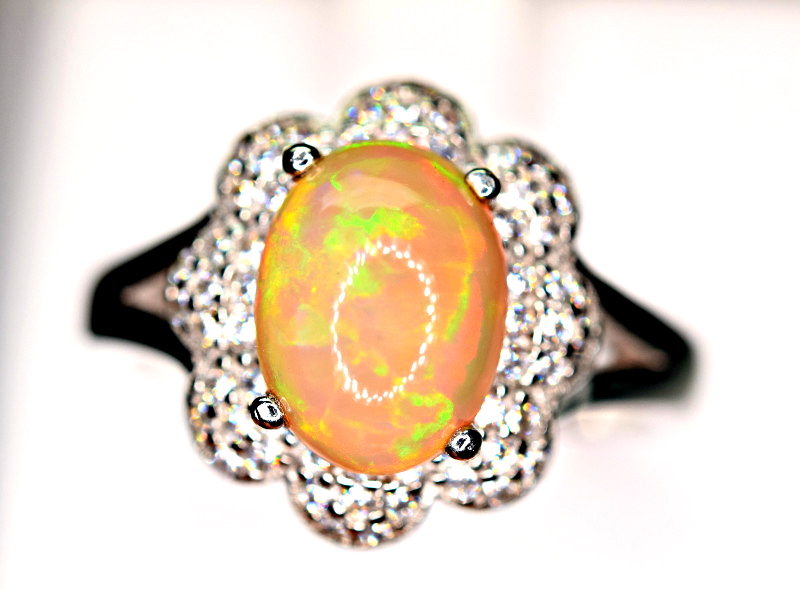 Oben abgebildet: Edelopalring
Oben abgebildet: Edelopalring
Historische und kulturelle Bedeutung der Geburtssteine für Oktober
Was ist der offizielle Geburtsstein für Oktober? Es gibt zwei offizielle Halbedelsteine, die als Geburtssteine für Oktober bezeichnet werden: Opal und Turmalin .
Aber warum gibt es für Oktober zwei Geburtssteine ? Nun, es waren nicht immer zwei.
Die ersten Geburtssteinlisten, die im 1. bis 5. Jahrhundert n. Chr. erstellt und von Edelsteinlisten aus der Bibel inspiriert wurden, führten den Beryll (bzw. Aquamarin) als Geburtsstein für den Oktober.
Moderne formalisierte Listen entstanden im Jahr 1870, als Tiffany & Co. eine Broschüre mit „Gedichten zu gregorianischen Geburtssteinen“ veröffentlichte. Das Gedicht für Oktober handelte vom Opal.
Die erste standardisierte Liste stammte 1912 von der National Association of Jewellers (heute Jewellers of America), die den Opal als primären Geburtsstein für Oktober und den Turmalin als Alternative festlegte.
In den 1950er Jahren ergänzte der Jewellery Industry Council of America die Liste von 1912 und nannte speziell rosa Turmalin als Oktober-Alternative.
Auf der aktuellsten amerikanischen Liste von 2016 haben Opal und rosa Turmalin für Oktober die gleiche Priorität. Auf der britischen Liste von 2013 steht nur Opal.
Überraschenderweise sind die beiden Juwelen, die den „dunklen und gruseligen“ Monat Oktober ehren, größtenteils in der Überlieferung zum Thema Regenbogen verwurzelt.
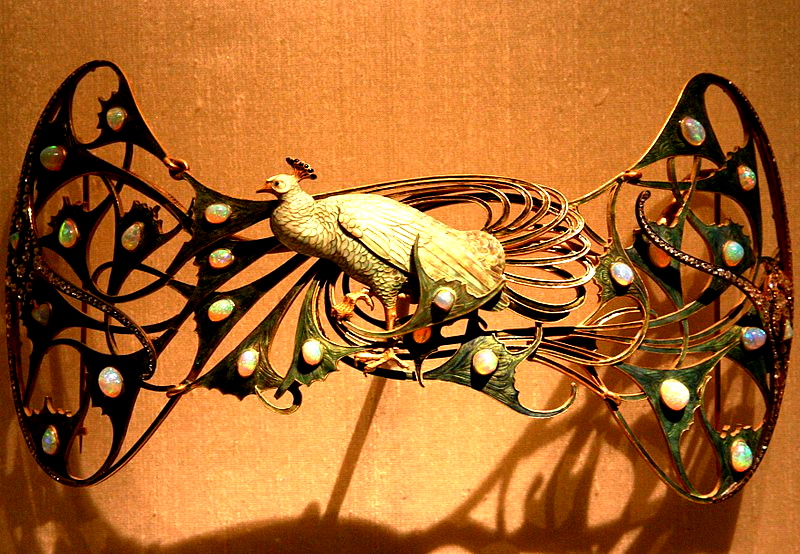 Oben abgebildet: René Lalique (1860-1945); Ansteckornament „Pfau“, ca. 1898–1900, mit Gold, Opalen, Diamanten und Emaille; Calouste Gulbenkian Museum | Bildnachweis: © José Luiz Bernardes Ribeiro / CC BY-SA 3.0
Oben abgebildet: René Lalique (1860-1945); Ansteckornament „Pfau“, ca. 1898–1900, mit Gold, Opalen, Diamanten und Emaille; Calouste Gulbenkian Museum | Bildnachweis: © José Luiz Bernardes Ribeiro / CC BY-SA 3.0
Opals mythische Ursprünge und antike Folklore
Die alten Griechen glaubten, dass Opale aus den Freudentränen des Himmelsgottes Zeus entstanden, nachdem er die Titanen besiegt hatte.
Die alten Römer betrachteten den Opal als den König der Edelsteine. Ein römischer Gelehrter, Plinius der Ältere, schrieb, Opale hätten alle besten Eigenschaften anderer wertvoller Edelsteine wie Rubin , Smaragd und Amethyst .
Die Opalkunde der australischen Ureinwohner (manchmal auch „Aboriginal“ genannt) reicht Jahrhunderte zurück.
Ein Mythos über die Herkunft des Opals handelt von der Regenbogenschlange , einem mächtigen Wesen, das zwischen Wasserlöchern flog und dessen schillernde Schuppen als Opale auf die Erde fielen.
Ein weiterer Mythos über die Entstehung des australischen Opals besagt, dass der Geist eines Schöpfers auf dem Regenbogen zur Erde gelangte und dass dort, wo seine Füße den Boden berührten, Opale entstanden.
Einem alten indischen Mythos zufolge verwandelte die Muttergöttin die jungfräuliche Göttin des Regenbogens in einen Opal, um ihr zu helfen, der unerwünschten Zuneigung mehrerer Götter zu entgehen, die sie verfolgten.
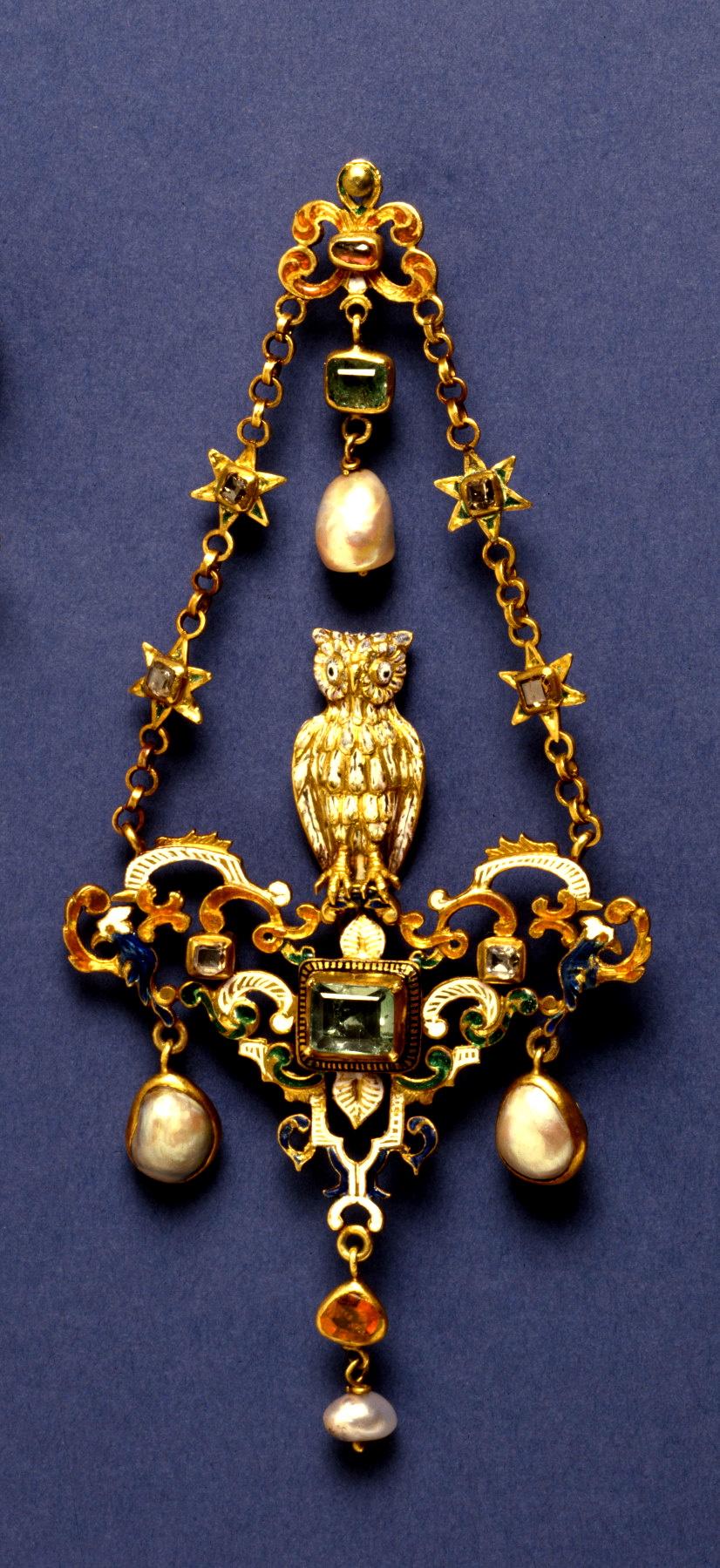 Oben abgebildet: Goldener Eulenanhänger mit Turmalin, Rubin, Diamant und Perle; Datiert auf das 19. Jahrhundert, früher wurde angenommen, dass er aus dem 16. Jahrhundert stammt; Ausgestellt im Walters Art Museum | Bildnachweis: Walters Art Museum, gemeinfrei
Oben abgebildet: Goldener Eulenanhänger mit Turmalin, Rubin, Diamant und Perle; Datiert auf das 19. Jahrhundert, früher wurde angenommen, dass er aus dem 16. Jahrhundert stammt; Ausgestellt im Walters Art Museum | Bildnachweis: Walters Art Museum, gemeinfrei
Die vielfältigen historischen Verbindungen des Turmalins
Turmalin hat eine etwas kürzere Geschichte als Opal, ist aber ebenso faszinierend.
Der Name dieses Geburtssteins für Oktober stammt vom singalesischen (sri-lankischen) Wort „turmali“, was „gemischte Edelsteine“ bedeutet. Niederländische Kaufleute prägten den Namen für bunte Steine in Edelsteinpaketen in Sri Lanka.
Der niederländische Handel mit „Schörl“ (schwarzem Turmalin) geht mindestens auf das 15. Jahrhundert zurück, wenn nicht sogar noch früher.
Eine weitere historische Entdeckung des Turmalins erfolgte im Jahr 1554. Der spanische Konquistador Francisco Spinoza fand in Brasilien einen grünen Turmalin, den er „Brasilianischer Smaragd“ nannte.
Eine weitere bemerkenswerte Fehlidentifikation von Turmalin ist der „ Caesars Rubin “, ein roter Stein, dessen Geschichte im französischen und russischen Königshaus bis ins 16. Jahrhundert zurückreicht. In den 1920er Jahren stellte sich heraus, dass es sich um einen Rubellit-Turmalin handelte.
Tatsächlich bezeichneten Händler farbige Turmaline wahrscheinlich als andere Edelsteine, bis 1785 die erste Art (Schörl) analysiert wurde. Die Art wurde erst nach der Entdeckung von Bor im Jahr 1808 vollständig erkannt.
Nachdem 1892 in Kalifornien Turmalin entdeckt wurde, wurde ein Großteil der rosa Turmaline des Staates an die chinesische Kaiserinwitwe Tz'u Hsi verkauft, die den Edelstein sehr mochte.
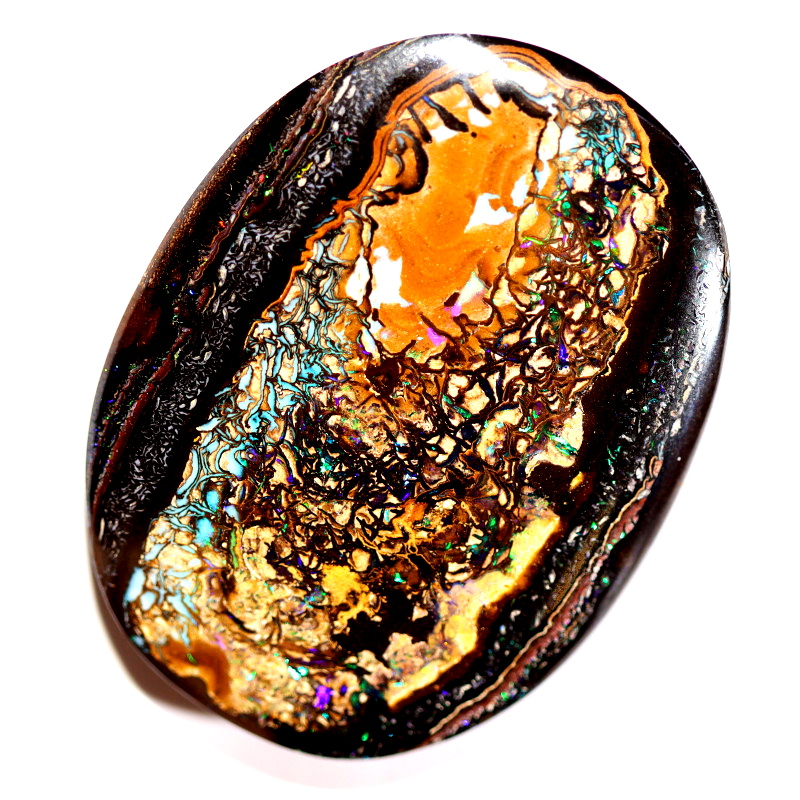 Abbildung oben: Polierter Matrixopal
Abbildung oben: Polierter Matrixopal
Geologisches Wunder: Die Entstehung von Opalen und Turmalinen
Beginnen wir mit Opalen . Diese Edelsteine sind amorphe Mineraloide ohne kristalline Struktur. Sie bestehen aus Kieselsäure und unterschiedlichem Wassergehalt.
Ein Opal entsteht , wenn sich Wasser mit gelöster Kieselsäure in einem Bereich wie einem Eisenspalt oder einer Rhyolith- Geode („Donnerei“) absetzt. Wenn das Wasser verdunstet, verfestigt sich das Gel zu Opal.
Der Edelstein kann sich auch um Fossilien wie urzeitliche Meeresbewohner (z. B. Belemnit-Opal) oder Holz herum bilden.
Aber Opal ist auch ein Weltraumstein ! Sowohl 2015 als auch 2023 wurden auf dem Mars Opale gefunden , was beweist, dass es auf dem Planeten Wasser gibt.
Der Turmalin , der Geburtsstein für Oktober, hat eine ähnliche Form.
Turmalin entsteht in sehr tiefen, heißen hydrothermalen Lagerstätten, wenn sich Wasser mit gelöstem Bor und Kieselsäure in Magmaspalten absetzt. Das Magma härtet allmählich zu Gestein aus, das Wasser verdunstet und die Elemente kristallisieren.
Bergbaustandorte
Rund 95 Prozent des weltweiten Edelopalvorkommens stammen aus Australien.
Die meisten Turmalin-Edelsteine stammen aus Brasilien oder afrikanischen Ländern. Kalifornien in den USA ist berühmt für seinen rosa Turmalin.
 Abbildung oben: Gewöhnlicher orangefarbener Feueropal, facettiert
Abbildung oben: Gewöhnlicher orangefarbener Feueropal, facettiert
 Oben abgebildet: Edelopal aus Lightning Ridge, Australien, mit lebhaftem Farbenspiel
Oben abgebildet: Edelopal aus Lightning Ridge, Australien, mit lebhaftem Farbenspiel
Die verspielten Farben des Opals: Die Magie im Inneren enthüllen
Die umfassendsten Opalkategorien sind gewöhnlicher Opal und Edelopal .
Der Opal, der Geburtsstein für Oktober, besteht aus Kieselsäurekugeln, die von Wasser umgeben sind. Sind die Kugeln ungleichmäßig angeordnet und haben unterschiedliche Größen, entsteht gewöhnlicher Opal. Gleichmäßig große und angeordnete Kugeln (wie ein Buckyball) ergeben Edelopal.
Nur der „Edelopal“ weist ein Farbenspiel auf, bei dem schillernde Farben von seiner Oberfläche aufblitzen.
HINWEIS: Manche Gemmologen verwenden „Farbspiel“ synonym mit „ Opaleszenz “. Andere definieren Opaleszenz als das milchige oder fast perlmuttartige Aussehen einiger gängiger Opale.
Verschiedene Opalarten werden hauptsächlich nach ihrem Körperton (Hintergrundfarbe), ihrer Transparenz und ihrem Farbenspiel kategorisiert.
Die wichtigsten Arten von Opalkörpertönen sind weißer Opal , grauer Opal und schwarzer Opal . Diese werden mithilfe einer Körpertontabelle unterschieden.
Zu den Opalen mit anderen Körperfarben gehören:
Lila Morado-Opal
Feueropal (rot, orange und/oder gelb)
Zu den farblosen Opalarten gehören Kristallopal , Contraluz-Opal und Jelly-Opal . Hyalit-Opal kann farblos sein. Hydrophan-Opal wird in Wasser durchsichtig und farblos.
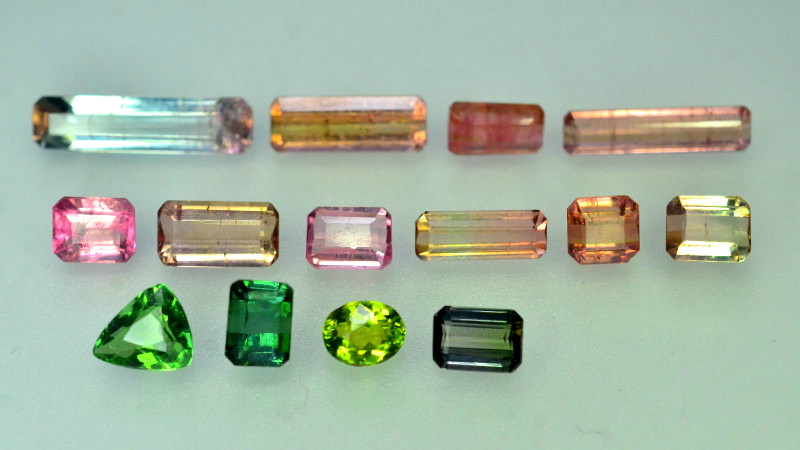 Oben abgebildet: Verschiedene Farben und Varianten facettierter Turmaline
Oben abgebildet: Verschiedene Farben und Varianten facettierter Turmaline
Die vielen Gesichter des Turmalins
Turmalin ist eine komplexe, vielfältige Gruppe von über 30 Mineralien. Die häufigsten Arten sind:
Schörl : Häufigste Art, etwa 95 Prozent aller natürlichen Turmaline; Braun bis Schwarz
Dravit : Relativ häufig; Spitzname „brauner Turmalin“, kann aber auch andere Farben haben
Elbait : Die häufigste Art in Edelsteinqualität, die bekannteste und wertvollste; kann praktisch jede Farbe haben oder mehrfarbig sein
Jede Art kann Varianten mit unterschiedlichen Farben hervorbringen. Die am häufigsten verkauften Turmalin-Varianten:
Schwarzer Turmalin : Nur Schörl-Variante; häufigster Turmalin; immer undurchsichtig
Chromturmalin : Dravit; Seltenes leuchtendes Grün
Indigolith : Elbait; überwiegend blau
Paraiba-Turmalin : Elbait; Intensiv gesättigtes Neonblau bis Blaugrün oder Violett
Rubellit : Normalerweise Elbait; gesättigte rosa bis rubinrote Variante, mögliche violette, braune oder orange Untertöne
Verdelit : Elbait; grüne Varietät, oft „brasilianischer Smaragd“ oder „ceylonesischer Peridot “ genannt
Wassermelonen-Turmalin : Elbait; zweifarbig rosa und grün, typischerweise mit einer rosa Mitte und einem grünen Rand, manchmal durch eine farblose Schicht getrennt
Siberit : Elbait, manchmal als Rubellit-Untertyp angesehen; Spitzname „lila Turmalin“, obwohl er normalerweise rötlich-violett oder violett-rot ist
Der rosa Turmalin ist eine Elbait-Variante und wird oft als Rubellit oder Siberit bezeichnet. Zu den mehrfarbigen Optionen gehören rosa und grüner Wassermelonen-Turmalin sowie rosa und orangefarbener „Sonnenuntergangs-Turmalin“.
Die seltenste Turmalinvariante ist der Paraíba-Turmalin. Rein gelbe, orange, blaue, violette oder farbwechselnde Turmaline sind ebenfalls selten.
Ein weiterer Faktor ist der Pleochroismus , für den Turmalin geschätzt wird. Exemplare mit starkem Pleochroismus sind wertvoller.
Apropos Wert: Wie werden die Geburtssteine für Oktober bewertet?
 Abbildung oben: Facettierter Wassermelonenturmalin
Abbildung oben: Facettierter Wassermelonenturmalin
Qualitätsbewertung: Eigenschaften von Opal und Turmalin
Die Bewertung von Turmalin ist deutlich einfacher als die von Opal. Im Folgenden konzentrieren wir uns auf die Standardfaktoren für den Wert von Edelsteinen – Farbe, Schliff, Reinheit, Karatgewicht und Behandlungen – sowohl für Opal als auch für Turmalin. Weitere Informationen zur Bewertung von Opal finden Sie hier .
Farbe
Opal : Die wichtigsten Wertfaktoren für diese Geburtssteine sind die Farbe des Opals (Körperton) und das Vorhandensein von Farbspielen. Die häufigste Opalfarbe nach Körperton ist Weiß, gefolgt von Grau und Grün. Am seltensten sind Schwarz oder Rot. Edelopale sind insgesamt deutlich wertvoller als gewöhnliche Opale.
Das beste Farbspiel weist rote (oder alle Farben) Blitze auf, zeigt einzigartige Muster und bedeckt die gesamte Oberfläche des Steins. Dunklere Exemplare wie kostbare schwarze Opale weisen ein helleres Farbspiel auf, was ihren Wert steigert.
Turmalin : Der seltenste und wertvollste Turmalin-Geburtsstein für Oktober ist der Paraiba-Turmalin. Schwarze, rote und rosa Turmaline sind häufiger. Hellgrüne und blaue Pleochroismen, Mehrfärbungen oder Farbwechsel können den Wert des Geburtssteins steigern.
Schneiden
Opal : Opale werden nicht so häufig facettiert wie andere Edelsteine – die häufigste Facettenvariante ist der Feueropal. Am häufigsten sieht man Opale in Cabochons oder Perlen geschliffen. Das Farbspiel kommt bei durchscheinenden bis undurchsichtigen Opal-Cabochons oder vollständig transparenten facettierten Opalen am besten zur Geltung. Viele Opal-Cabochons sind zusammengesetzt, wie Opal-Dubletten oder -Tripletten .
Turmalin : Turmalin-Edelsteine sind oft facettiert, oft in länglicher, rechteckiger Form. Brillantschliffe können für wertvollere Sorten wie Paraiba-Turmalin gewählt werden. Turmaline mit starken Einschlüssen werden oft als Cabochons oder Schnitzereien verarbeitet, während zweifarbige Steine geschnitten werden können.
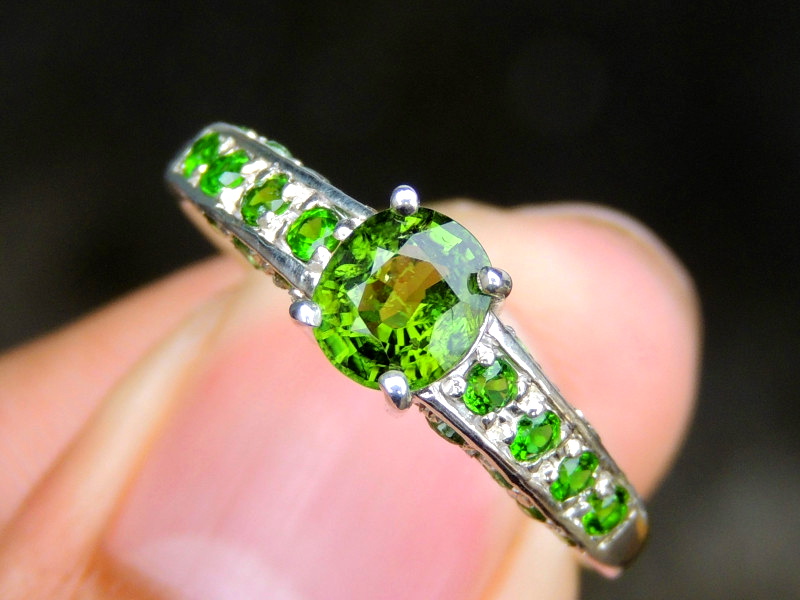 Abbildung oben: Facettierter Chrom-Turmalin-Ring
Abbildung oben: Facettierter Chrom-Turmalin-Ring
Klarheit und Transparenz
Die Reinheit beschreibt den Grad der sichtbaren Einschlüsse in einem Stein, die seine Transparenz und seinen Wert mindern.
Opal : Einschlüsse mindern im Allgemeinen den Wert von Opalen. Einige Einschlüsse und zusätzliches Material um einen Opal herum führen zu verschiedenen Varietäten wie dendritischem Opal , Matrixopal und Boulderopal .
Vollständige Transparenz ist bei Opalen selten und wertvoll, obwohl schwarze Opale undurchsichtiger sind. Trübung mindert in der Regel den Wert.
Turmalin : Die meisten Turmaline haben Reinheitsgrad II , was bedeutet, dass kleinere sichtbare Einschlüsse zu erwarten sind. Chrom- und grüne Turmaline gehören zum Typ I (normalerweise einschlussfrei), während Paraiba-, Rubellit- und Wassermelonenturmaline zum Typ III gehören (immer sichtbare Einschlüsse).
Mehr sichtbare Einschlüsse und geringere Transparenz bedeuten einen geringeren Wert des Turmals. Der einzige wertsteigernde Einschluss sind ausgerichtete Röhren, die Chatoyance („Katzenaugen“-Effekt) verursachen.
Turmalin selbst ist ein Einschluss in Turmalinquarz .
Karatgewicht
Opal : Bei selteneren Opalen wie Schwarz- oder Kristallopal können die Preise pro Karat in Abständen von 1–5 Karat, 5–10 Karat und 10+ Karat schwanken.
Turmalin : Turmalin-Geburtssteine gibt es in verschiedenen Größen, Edelsteine über 5 Karat sind jedoch teurer. Auch die Vielfalt spielt eine Rolle – Chromturmalin wird häufig bis zu 5 Karat gefunden, Paraiba-Turmalin hingegen ist selten größer als 1 Karat.
Behandlungen
Opal : Unbehandelte Opale sind deutlich wertvoller als behandelte, insbesondere seltene Sorten wie Schwarzopal. Hier erfahren Sie, wie Sie Opalbehandlungen testen können, oder Sie bringen Ihren Geburtsstein für Oktober zur Bestätigung in ein Labor.
Turmalin : Behandlungen mindern zwar den Wert des Turmalins, sind aber bei diesem Geburtsstein für Oktober üblich. Zu den üblichen Behandlungen (oft zur Verbesserung der Farbe oder Klarheit) gehören Bestrahlung , Wärme und/oder Rissfüllung.
 Abbildung oben: Australischer schwarzer Opalanhänger
Abbildung oben: Australischer schwarzer Opalanhänger
Bedeutung der Geburtssteine für Oktober und kulturelle Überzeugungen
Welche spirituelle Bedeutung haben die Geburtssteine für Oktober? Neben der Verbindung beider Edelsteine mit Regenbögen hat jeder von ihnen seine eigene einzigartige Symbolik und mystische Eigenschaften.
Opalbedeutungen
Nach alten Interpretationen symbolisieren Opale Reinheit, Hoffnung und Perspektive. Die Römer nannten Opale Cupid Paederos oder „Kind so schön wie die Liebe“.
Obwohl Opale im 19. Jahrhundert aufgrund des Aberglaubens, sie seien verflucht, vorübergehend verfärbt wurden , glaubten viele alte Gesellschaften, wie beispielsweise China, dass Opale Glück bringen. Ein weit verbreiteter Aberglaube hält sich hartnäckig: Wer nicht im Oktober geboren ist, bringt Unglück, wenn er Opal trägt.
Als Heilstein werden Opale vor allem für das Sehen und den Geist verantwortlich gemacht. Zu den heilenden Kräften des Oktober-Geburtssteins gehören die Behandlung von Sehproblemen, die Verbesserung der kognitiven Fähigkeiten und die Möglichkeit, in die Zukunft zu sehen.
Turmalin Bedeutungen
Insgesamt symbolisiert der Turmalin als Geburtsstein für Oktober Mitgefühl, Aufgeschlossenheit und Vergebung. Er wird manchmal auch als „Stein der Versöhnung“ bezeichnet.
Jede Turmalinfarbe hat ihre eigene Bedeutung und Heilkraft. Der rosa Turmalin, der sich auf den Oktober konzentriert, soll die Energie steigern, die Liebe fördern und helfen, Beziehungsprobleme zu lösen.
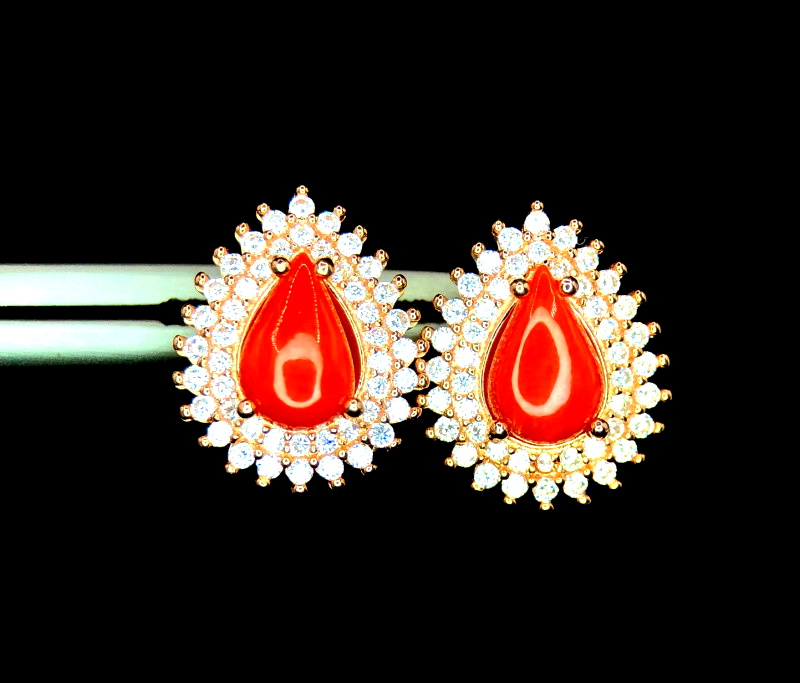 Oben abgebildet: Ohrringe aus roter Koralle
Oben abgebildet: Ohrringe aus roter Koralle
Alternative Geburtssteine für Oktober
Welcher ist der beliebteste Geburtsstein für Oktober? Opal ist normalerweise der „Klassiker“ und beliebter als Turmalin, aber es gibt noch andere Geburtssteine und Kristalle für Oktober!
Beliebte Alternativen zu den Geburtssteinen für Oktober sind Beryll und Koralle .
Was ist astrologisch gesehen der Geburtsstein der Waage ? Im September (nach dem 23.) geborene Waagen können von Peridot, Rosenquarz und Morganit profitieren.
Was ist mit den Geburtssteinen des Skorpions ? Im September (vor dem 23.) geborene Skorpione können von schwarzem Turmalin, Malachit und Koralle profitieren.
Personalisierte Geschenke mit Geburtssteinen für Oktober
Sie haben den Edelstein. Was machen Sie nun damit? Ein tolles Geschenk mit einem Oktober-Geburtsstein kommt von Herzen und feiert Ihren im Oktober geborenen Liebsten.
Da der Oktober zu den Monaten mit den meisten Hochzeiten gehört, ist ein Ring mit einem Geburtsstein für Oktober auch eine tolle Möglichkeit, dies zu feiern!
Sie können sich sogar individuellen Schmuck zulegen, beispielsweise eine Halskette mit dem Geburtsstein für Oktober im Design einer Ringelblume, der Geburtsblume des Monats.
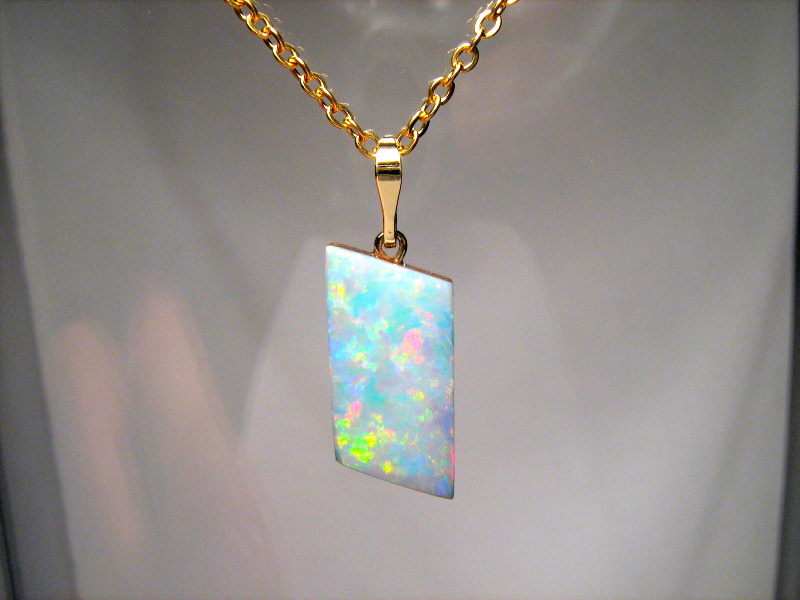 Abbildung oben: Halskette mit weißem Edelopal-Anhänger
Abbildung oben: Halskette mit weißem Edelopal-Anhänger
Überglücklich über die Geburtssteine für Oktober?
Turmalin und Opal sind aufgrund ihrer Farbvielfalt und ihres einzigartigen Aussehens beliebt. Bevorzugen Sie den kürzlich offiziell anerkannten rosa Turmalin, den älteren, traditionellen Opal oder einen anderen Oktober-Geburtsstein? Folgen Sie Ihrem Herzen und finden Sie den Edelstein, der Ihnen am besten gefällt!
Finden Sie traditionelle und alternative Geburtssteine für Oktober unter unseren Hunderten von verfügbaren Edelsteinen oder stöbern Sie in unserer umfangreichen Opalauswahl bei Opal Auctions .
Suche nach Gemstone Encyclopedia
Verwandte Auktionen
In Verbindung stehende Artikel
Russland ist ein riesiges Land mit unermesslichen Mineral- und Edelsteinreserven. Russland hat sich zu einem bedeutenden Diamantenproduzenten und -produzenten entwickelt.
9th May 2018
Werfen wir einen Blick auf die 10 größten Diamanten, die je gefunden wurden. Sie werden nie erraten, wie groß der Diamant ist, der den ersten Platz belegt.
9th May 2018
Asien ist eine Region der Erde, die einige der außergewöhnlichsten Edelsteine hervorbringt. Rubin, Saphir und Spinell stammen alle aus dieser Region.
9th May 2018
Neue Artikel
Chrysanthemenblütensteine sind Naturwunder mit einem weißen Kalzit-, Celestin- oder Andalusit-Blumenmuster, das sich vom schwarzen Kalkstein oder Tonstein abhebt.
13th Jan 2026
Der Regenbogen-Gitter-Sonnenstein ist eine Feldspatvarietät mit drei wunderschönen optischen Effekten, die durch verschiedene Einschlüsse hervorgerufen werden. Sein feuriges Farbenspiel und das Gittermuster machen ihn zu einem seltenen Sammlerstück!
12th Jan 2026
Thulit ist ein seltener norwegischer Edelstein aus der Zoisit-Mineralfamilie, der einen leuchtend rosafarbenen Farbton aufweist und häufig für Schmuckfassungen und Anhänger verwendet wird.
6th Jan 2026
Artikelkategorien
How To's is where you will find helpful articles from gem Rock Auctions on how to cut gemstones, select gemstones and buy gemstones.
9 Artikel




